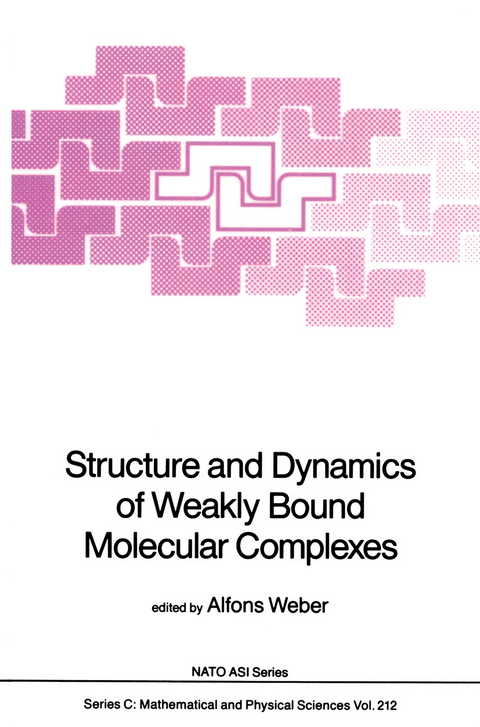
Structure and Dynamics of Weakly Bound Molecular Complexes
Springer (Verlag)
978-94-010-8261-7 (ISBN)
The study of weakly bound molecular complexes has in recent years brought this field of investigation to the forefront of physical and chemical research. The scope of the subject is wide and different terminology and nomenclature is current among the various subspecialties. Thus, the term "metal cluster" often connotes to the organic chemist a metal-organic compound, while the physicist will more likely think of groups of metal atoms held together by weak interatomic forces. Aggregates, clusters, complexes, van der Waals molecules, hydrogen-bonded molecules, etc. are terms currently in use, sometimes interchangeably while other times with well defined and mutually exclusive meanings. The subjects of this volume are the free, isolated vim der Waals and hydrogen-bonded molecules. Owing to the present state of experimental knowledge these are mostly dimers, i. e. , entities formed by two strongly bound molecules, an atom and a molecule, or two atoms held together by the weak hydrogen-bonding, or the still weaker van der Waals forces. Weakly bound complexes formed of more than two strongly bound sub-units, i. e. , trimers, tetramers, etc. , are now coming within reachof experimental observation and several papers in this book deal with them. The study of van der Waals and hydrogen-bonded interactions has been pursued for several decades. Most of these ,investigations have, however, dealt with systems in the condensed phase in which bulk effects are commingled with and therefore mask the weak binary interactions.
I. Spectroscopy, Structure, Potentials.- A. Rotational Spectra.- Rotational Spectroscopy of Weakly Bound Complexes: Capabilities and Limitations.- Pulsed-Nozzle, Fourier-Transform Microwave Spectroscopy of Hydrogen-Bonded Dimers.- Structure Determination of Weakly Bound Complexes.- Microwave Spectra and Weak Intramolecular Hydrogen Bonding in 3-Butene-1-Thiol and N-Methylallylamine.- B. Rotation-Vibrational Spectra.- High Resolution Infrared Spectroscopy of van der Waals Molecules.- Vibration-Rotation Spectroscopy of ArHCl by Far-Infrared Laser and Microwave/Far-Infrared Laser Double Resonance Spectroscopy.- Vibrational Anomalies and Dynamic Coupling in Hydrogen-Bonded van der Waals Molecules.- Slit Jet IR Absorption Spectroscopy of Molecular Complexes.- Sub-Doppler Resolution Infrared Spectroscopy of Binary Molecular Complexes.- The Infrared Spectrum of H2-Ar: New Observations in the v=l-0 and 2-0 Bands of H2.- Dynamical Properties of Simple Hydrogen-Bonded Clusters.- Infrared Spectroscopy of Hydrogen-Bonded and van der Waals Complexes.- Ab Initio Calculations of Vibrational Frequencies and Infrared Intensities for the Hydrogen- Bonded Complex HCN—HF.- The Role of Tunneling Models in Analyzing High- Resolution Spectra of Weakly Bound Molecular Complexes.- Bibliography of Rotational Spectra of Weakly Bound Complexes.- C. Electronic Spectra.- Structure and Dynamics of Mercury van der Waals Complexes.- The Structure of van der Waals Molecules of s-Tetrazine.- Spectra of Mixed Dimers.- Solvent Shifts, Spectroscopy and Structure in van der Waals Complexes of Perylene.- Spectroscopy in the Visible and Near Ultraviolet Region of Some Organic Molecules and their van der Waals Complexes.- Supersonic Jet Spectroscopy of Complexes of Carbazole and N-Ethyl Carbazole with AlkylCyanides.- Photoionization of Hydrogen-Bonded Molecular Aggregates.- D. Potential Functions.- The Unavoidable Importance of Electrostatic Effects in the Structures of Weakly Bonded Complexes.- Intermolecular Potentials, Internal Motions and the Spectra of van der Waals Molecules.- Non-Bonding Atom-Diatom Potentials via a Double Many-Body Expansion Method.- The Determination of Intermolecular Forces by Data Inversion Methods.- Transport Properties of van der Waals Molecules Computed from Accurate Interactions.- Determination of Anisotropic Interaction Potentials from Rotational State Resolved Scattering Data.- van der Waals Interactions from Glory and Diffraction Scattering.- High Resolution Crossed Molecular Beam Studies of van der Waals Forces.- E. Summary: Part.- Where Are We in Weak Intermolecular Interactions?.- II. Dynamics.- Interpretation of Linewidths in the Infrared Photodissociation Spectra of van der Waals Molecules.- Infrared Photodissociation of van der Waals Complexes Selectively Prepared by Molecular Beam Scattering.- IR Dissociation of Weakly Bound van der Waals Complexes: (SF6)n, (SiF4)n, (SiH4)n, (C2H4)n,(n=2,3) in the 9–11 in ?m Range.- Infrared (9–11?m) Dissociation of the Hydrogen Bonded Clusters (NH3)n (n?2)Detected by Bolometric Technique.- Highly Excited Systems.- Vibrational Predissociation Dynamics of the Nitric Oxide Dimer.- Complex Forming Reactions in Noble Gas Clusters.- Structure and Dynamics of the Rare Gas-Halogen van der Waals Molecules: Product State Distributions for Vibrational Predissociation of NeBr2.- Dynamics of Energy Transfer in van der Waals Molecules of s-Tetrazine and Argon.- Theory of van der Waals Photofragmentation Dynamics.- Dissociation Dynamics of the He-I2-Ne van der Waals Complex.- Dynamics of the Ar---H2van der Waals Complex: A Diabatic Distorted Wave Approach Including Discrete-Discrete Couplings.- Vibrational Predissociation Dynamics of Weakly Bonded Dimers: A Summary.- List of Participants.- List of Contributors.- List of Poster Papers.- List of Names.
| Reihe/Serie | NATO Science Series C ; 212 |
|---|---|
| Zusatzinfo | 1 Illustrations, black and white; XVIII, 633 p. 1 illus. |
| Verlagsort | Dordrecht |
| Sprache | englisch |
| Maße | 155 x 235 mm |
| Themenwelt | Naturwissenschaften ► Chemie ► Physikalische Chemie |
| ISBN-10 | 94-010-8261-8 / 9401082618 |
| ISBN-13 | 978-94-010-8261-7 / 9789401082617 |
| Zustand | Neuware |
| Haben Sie eine Frage zum Produkt? |
aus dem Bereich


